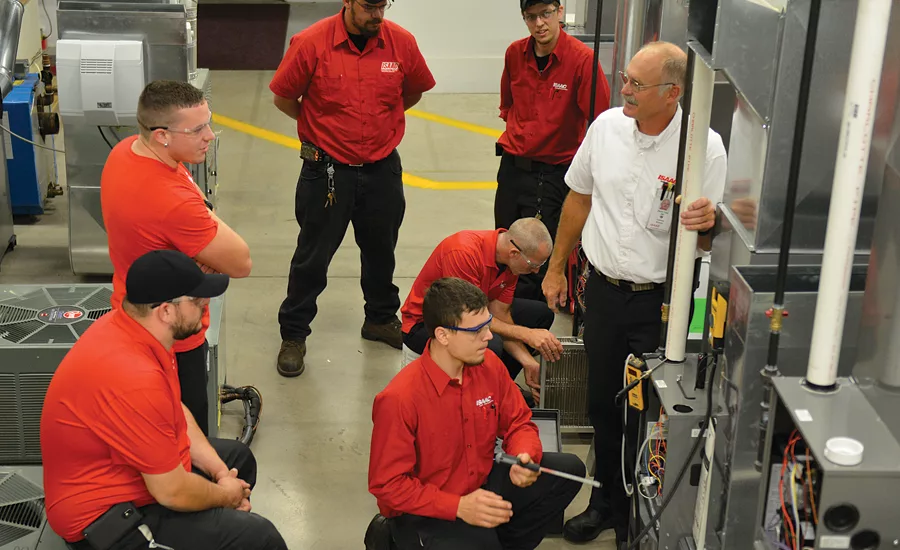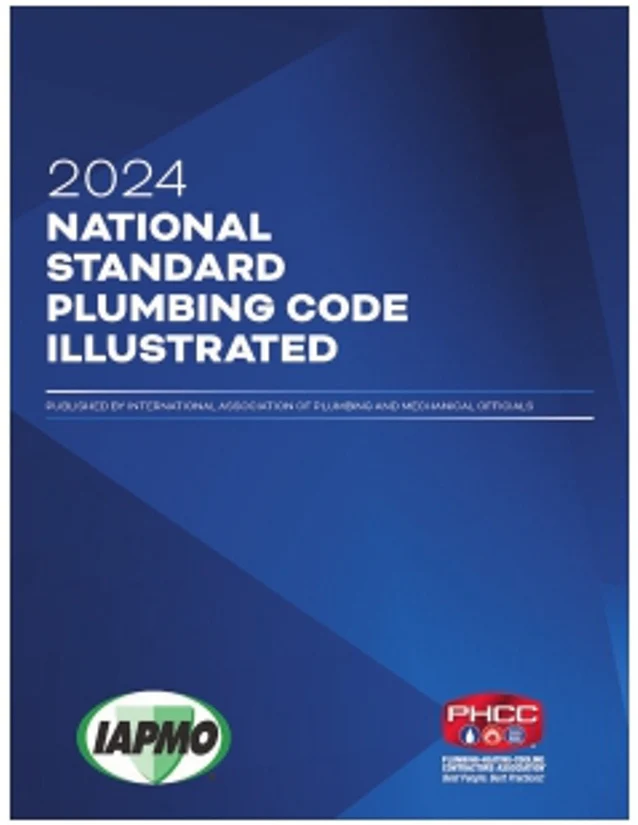Training the new generation of plumbers and HVAC techs


It has been said for many years now, by many companies, that it is hard to find skilled employees. It’s also been said that there aren’t enough young people coming into the industry to make up for rapidly retiring employees. The U.S. Bureau of Labor Statistics projects a 21% increase in the need for plumbing and HVAC technicians — more than 138,000 new workers — by the year 2022.
These next six years will be difficult for many companies, but a few have begun to prepare. By offering ride-alongs, summer internships and training programs, these companies are catching the eyes of the younger generation and helping them learn more about the plumbing and heating trades.
Targeting the 18- to 24-year-old market, Plumbing-Heating-Cooling Contractors of Indiana’s “Best Career 4 You” website promotes the modern plumbing profession while also focusing on what recent high school and college grads want to know — earning potential and job security.
It began with the assembly of a task force on workforce development, created by John Bain, chairman of Indiana PHCC, and his fellow board of directors. The group engaged a marketing consultant and reviewed the materials available about plumbing careers but felt they weren’t designed to reach the 18 to 24 demographic.
“BestCareer4You.com was developed to graphically and stylishly appeal to that demographic,” says Brenda Dant, CAE, executive director of Indiana PHCC. “Using Google AdWords, we have purchased ads and are able to track which messages and graphics resonate best. The ability to test the messages and key words is crucial to the success of the website. We have found which messages are better motivators for this audience to help us place our ads more effectively.”
The system is designed to send out an email, formatted to be mobile friendly, to the requestor with some general information. The requestor’s email address is then sent out to an Indiana PHCC member in that county and they have 48 hours to personally make contact with the requestor. The recent addition of a text option as opposed to email has increased the efficiency of the website.
The website launched in August 2015. As of June 2016, the ads have been viewed on Google search pages by more than 762,000 people. Of those, 5,500 have clicked through to the site to read more; and 405 have submitted the form to connect with an Indiana PHCC Contractor.
“We are working with the school guidance counselor association to design materials and delivery formats that work best for them,” Dant adds. “We have booths at their events and are working with local career programs.”
Community involvement
Texas PHCC member Sam Dowdy, owner of S&D Plumbing, also participates in local career days, as well as several other recruiting programs. Dowdy and his team host career day events for students of all ages from kindergarten to high school.
He started his Plumbing Pipeline Program because he saw an opportunity in a different way of hiring. “I recreated a version of how I got into the trade when I was young,” Dowdy says. “I went to the local school and spoke directly with the superintendent. Our conversation was simple and went something like this: ‘Tommy, you and I both know that not every kid needs to go to college. If you can provide me two kids you know are not college bound, like working with their hands and don’t mind getting dirty, I can provide a great career path for them. Let’s build a partnership.’”
Originally, it started as a simple partnership between S&D Plumbing and Thrall High School. In year two, Thrall created a co-op partnership between Dowdy’s company, five local high schools and the local community college. The schools referred to it as the Eastern Williamson County School Co-op. The partnership was set up so the five high schools provided the students, the college provided the plumbing classes and S&D provided the apprentice programs/jobs.
Because the students are encouraged to get jobs in the field after completing the program, the kids have to be 16 years old and have a driver’s license. Each student attends plumbing classes in the morning at the community college, high school classes in the afternoon and work at S&D after school, into the evening and over the weekends as a plumbing apprentice.
When used with the schools, it is a two-year program matching the students’ junior and senior year in high school. The ideal outcome of this model would be that the kids could possibly accumulate enough plumbing credit hours to be able to graduate high school with their first basic plumbing license.
“We all know there is a shrinking workforce to choose from in America,” Dowdy notes. “This program is already proving to be a successful way to recruit and retain employees. We have even expanded our program to recruit veterans. In the last two years we have successfully recruited and licensed four Navy veterans as journeyman plumbers. These guys bring quality traits to our team.”
Helping youth decide
Another program helping high school students understand if a job in the trades is right for them is Knoxville, Tenn.’s Ride and Decide program. Gordy Noe, president of Pioneer Heating and Air Conditioning in Knoxville, created the program in 2014 while he was the local PHCC president.
“I started the program because we have a problem finding experienced, skilled workers,” Noe says. “When we get a young person that would like to learn a trade, many times they have college loan debt with no degree, and we can only look back and wish they had found us before they went in debt to realize college wasn’t for them. We wanted to give kids a taste of the skilled trades before they make the decision to go to college, trade school, etc, while helping get future employees in trades that are struggling to find workers.”
The program is two years, placing students in a paid summer job after their sophomore year and with a local skilled trade business after their junior year. It starts in June after school is out and runs for four to eight weeks, depending on the student’s request. It is promoted through the schools and local businesses as well as the occasional free public service announcements on local TV and radio.
Summer 2015 marked a successful first year — placing 42 students in 20 businesses. Through PHCC, Nashville has plans to start its program next year. California got its program going this summer and Noe is in contact daily with several other states that would like to get started next year.
Noe stresses the importance of programs like these by letting parents, teachers and students know many skilled trades’ jobs pay more than jobs that require a college degree. Current college debt in the United States is more than $1.7 trillion and that doesn’t include what families have saved up and spent on college.
Of those who spend money on college, only about 50% ever get a degree and only about 20% of those that do can actually find a job in their field of study. The skilled trades offer excellent pay with no debt as well as paid apprentice schools, job security and opportunities for advancement such as management and possibly owning their own business someday.
Rather than by school year, Isaac Heating and Air runs its Isaac Boot Camp program based upon need. Applicants submit a resumè and one-paragraph statement and are selected based upon an interview and some initial testing. The boot camp is a 12-week paid training program that runs 9 a.m. to 4 p.m., five days a week, with the opportunity to join the Isaac team after graduation. The program is comprised of classroom as well as hands-on lab and in-the-field training, all taking place at Isaac University in Rochester, N.Y. There is no targeted age range for his program, and the ages of those hired after the boot camp happened to be between 25 and 35 years old.
Eric Knaak, vice president and general manager at Isaac’s, created the program because he too saw a need for more technicians. “We’ve been growing over the last several years,” he says. “What we wanted to do with the boot camp was introduce our trade to people who may not have considered that as a career option. We have a career advisor who’s also our recruiter. He will reach out to some of the local workforce development organizations. We also work with local veteran associations and high schools. In addition, we put it out on Craigslist, our website and online job boards. We also get the word out through different social media outlets.”
The Isaac Boot Camp program has run three times since it began in July 2015. The first boot camp started with 13 recruits, graduated 10 and retained 9. The second boot camp started with 15 recruits, graduated 11 and retained 8. The third is currently underway.
“We’re hopeful that by just being a little more diligent and cautious on our pre-qualifying tests and the in-lab training, we can be sure to find the best-fit candidates possible. This way, we’d have a higher graduation rate. We’re very happy with what we have, but if we start with 15 people, we’d like to see 13 or 14 graduate.”
Concerns and reservations
Many contractors have expressed fear that if they train their contractors, they will end up leaving them. This was Dowdy’s first objection within his business. “There is a risk in spending money to recruit and train new employees at this age,” he notes. “It would be really disappointing if one would leave right after completing apprentice school. However, I think it’s worth the effort. The students will have respect for us and what we have poured into their lives, and we’d hope someday the efforts would be returned as they mature.”
Noe agrees this issue will always be prevalent, but says it shouldn’t be a concern. “If I was worried about that, I would never train anyone, which would make me a part of the problem instead of part of the solution,” he says. “After 35 years in business, I find that I have trained much of my competition. The good thing is, most of those made business people and fair competition while helping protect the integrity of our industry.”
Knaak adds: “If someone wants to leave, then that really is the best thing for them to do because they’re not fully engaged or they’ve not fully bought into the way we do things here and that’s fine. We find anyone we lose from the program is typically not going to a competitor, but going to something else outside of the industry because they realized it may not be for them.”
It may seem daunting to put faith, money, time and other resources into a person who may or may not be working for you down the line, but it can be well worth it if/when it turns out in your favor.
“Spread the word on the excellent opportunities offered in the trades,” Dowdy encourages. “Hire kids and give them a chance but keep in mind it takes work and commitment from your whole company. Realize upfront that you’re not going to see results right away; it may take a couple of years to develop a great employee. The alternative is to keep doing the same thing everyone else is doing and get left in the dust when recruiting employees.”
Do you have a recruiting or training program in your company that is bringing new blood into the industry? We’d love to hear your story! Contact the editors at Plumbing & Mechanical by emailing Editor@PMmag.com.
Looking for a reprint of this article?
From high-res PDFs to custom plaques, order your copy today!










